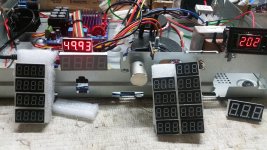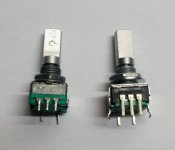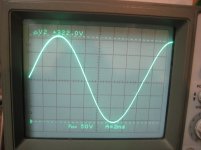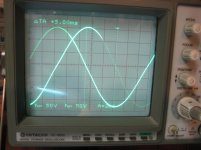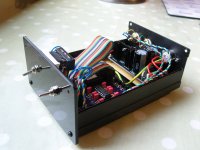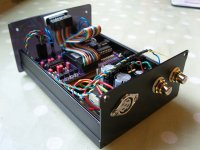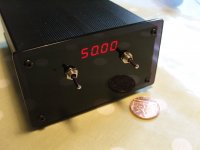Guess what? I emulated the issue you're facing, it does a frequency run when I purposely roll the knob very very quickly. I now experience exactly what you're seeing. I don't have any answer to this issue and reckon we shouldn't be flicking the encoder in this manner but turn in the normal fashion to fine adjust. Maybe its an Easter egg?
This is the part listed at Digikey. PEC11R-4220F-S0024 Bourns Inc. | Sensors, Transducers | DigiKey
I'm not buying from Digikey but from another vendor that make available to me where I live. I reckoned this is a better quality and suitable replacement part for the purpose. No harm trying.
Lee
This is the part listed at Digikey. PEC11R-4220F-S0024 Bourns Inc. | Sensors, Transducers | DigiKey
I'm not buying from Digikey but from another vendor that make available to me where I live. I reckoned this is a better quality and suitable replacement part for the purpose. No harm trying.
Lee
Last edited:
I am still getting requests for both the SG4 chip and the pcb.
I am currently very low on stock of the chips and completely out of boards.
I have sent a message to Bill (Pyramid) for more chips, and when I know they're coming I will also order boards. Please note I only supply boards singly; if you require 2 or more it's more cost effective to buy them direct from Oshpark (info on page 1 of this thread).
If anyone is anticipating ordering either chips or boards in the near future please send me a PM so I can anticipate how many to order.
I won't be replying to each request, but I will post on here when I have stock so formal orders can be made then.
Sorry for the delay.
Ralph
I am currently very low on stock of the chips and completely out of boards.
I have sent a message to Bill (Pyramid) for more chips, and when I know they're coming I will also order boards. Please note I only supply boards singly; if you require 2 or more it's more cost effective to buy them direct from Oshpark (info on page 1 of this thread).
If anyone is anticipating ordering either chips or boards in the near future please send me a PM so I can anticipate how many to order.
I won't be replying to each request, but I will post on here when I have stock so formal orders can be made then.
Sorry for the delay.
Ralph
Hi Coolmaster
Thanks for the link to the bourns encoder.
I think it must be a fault on the encoder or 4013 IC.
It is most likely the encoder. One of the lines from the encoder is remaining low when the frequency run happens. Either you have an encoder that does not pulse one of the lines, or it is getting caught in an in-between state and the line is getting hung low.
You can check for the first scenario by using an Ohmmeter on each line. Slowly turn the encoder and look for temporary pulses to ground on one line at a time. If the output stays low for every other position, it is the wrong type of encoder. Neither line should stay low in any rotated position, they should only pulse low.
Check for the second scenario the same way. Rapidly turn the knob in bursts and look for the Ohmmeter to remain low between bursts.
If either the up or down input to the SG4 is held low, the frequency will increase/decrease starting at 5x per second and increase to 20x per second the longer it is held.
It is most likely the encoder. One of the lines from the encoder is remaining low when the frequency run happens. Either you have an encoder that does not pulse one of the lines, or it is getting caught in an in-between state and the line is getting hung low.
You can check for the first scenario by using an Ohmmeter on each line. Slowly turn the encoder and look for temporary pulses to ground on one line at a time. If the output stays low for every other position, it is the wrong type of encoder. Neither line should stay low in any rotated position, they should only pulse low.
Check for the second scenario the same way. Rapidly turn the knob in bursts and look for the Ohmmeter to remain low between bursts.
If either the up or down input to the SG4 is held low, the frequency will increase/decrease starting at 5x per second and increase to 20x per second the longer it is held.
Hi Pyramid.
I have tested the encoder as you suggested, The output stays low sometimes and misses pulses other times.
You seem to have pinpointed the fault, thank you.
I have tested two encoders from different suppliers and found them both to be faulty.
Any suggestions on a good quality encoder, available in the UK, too many for me to choose from online.
I was thinking about the option of an optical encoder but suspect I would need a way to interface it with the SG-4. any suggestions?
Any of the encoders for the Arduino should work.
Does this only happen when the input is changed very rapidly (spinning the knob)? The SG4 will not accept rapid single pulses anyway, so not sure why you would do that. Testing mine, it does not work past 5-10 counts per second (although mine does not get stuck in up or down mode). If you need to make large frequency changes (when first setting the PSU to work with the table), hold the push button switches to make up to 20 counts per second.
Usually, the frequency is set using a strobe and is not readjusted unless something in the table changes.
Does this only happen when the input is changed very rapidly (spinning the knob)? The SG4 will not accept rapid single pulses anyway, so not sure why you would do that. Testing mine, it does not work past 5-10 counts per second (although mine does not get stuck in up or down mode). If you need to make large frequency changes (when first setting the PSU to work with the table), hold the push button switches to make up to 20 counts per second.
Usually, the frequency is set using a strobe and is not readjusted unless something in the table changes.
1 SG-4 and 2 MA-3D left
1 SG-4 & 1 MA-3D sold. 1 SG-4 and 2 MA-3D left.
Regards
Hi,
I’ve got two SG4 boards and also three MA-3D ones. I am selling them at 15$ each plus shipping.
If any interest please send private message.
Regards,
Jorge
1 SG-4 & 1 MA-3D sold. 1 SG-4 and 2 MA-3D left.
Regards
1 SG-4 & 1 MA-3D sold. 1 SG-4 and 2 MA-3D left.
Regards
The last SG-4 spoken for, awaiting payment.
2 MA-3D left...
Regards
Hello all,
Just like to share an ongoing experiments and musing with my SG-4 & Class D amp controller.
1) I mounted everything to an disused Sat top box chassis and its apparently working fine.
I've found that a 15VAC 60VA transformer is best suited here to power the TDA8950 module. I've tried 18V and 24VAC supply and its either overkill, the amp run hotter with no appreciable benefit. The 15VAC supply seems to suit well for purpose and intent.
Note that this amp require direct AC input unlike others which don't have onboard PSU DC rectification.
2) Much earlier, since I can't buy the recommended direct plug in Liteon 7 segment display from anywhere around my region, I bought a compatible common cathode and sorted the wires to fit. All well and fine. What I could find locally to buy is a 0.5" 7 segment module and no other choices. Stores here have very limited choice and not a popular product. Alright, that would do as long as it works meantime. 0.5" isn't small, it looks big and it is. I then searched around Aliexpress and found 0.36" common cathode/RED 4 digit and 3 digit modules easily available. The 4 digit and 3 digit lots arrived 2 weeks later from China. I did a swap and it looks good, looks exactly what I felt correct when mounted in a proper aluminum chassis. Its easily legible from my listening spot.
3) Next is the 3 digit display. Sometime ago I bought a cheap panel AC voltmeter (100V to 300V) with 3 digit 7 segment display. This product is connected to the transformer output and will display the output voltage to turntable. I found this necessary for any adjustment, calibration and monitoring purpose. It is intended to be mounted along with the SG-4 display. The problem was this AV voltmeter is fitted with a 3 digit 0.5" size display.
Having two 0.5" display could ultimately look a bit too large. I hacked the AC Voltmeter, found that its a 3 digit common cathode. After the new 0.36" 7 segment arrived, I immediately swapped it and it worked. The AC Voltmeter is now with a 0.36" LED and so far so good, no issues.
4) The next issue is the display brightness at SG-4 and AC Voltmeter.The SG4 display is much brighter and may look odd later on. I started to experiment with the SG-4. There's eight 330ohm resistors to the display. Since its already there, I don't want tedious work to replace any of it and leave it be. I'd series another 80 to 100ohm resistor to each of the segment at the LED module terminals and it reduced the brightness to be comparable to the AC voltmeter display. I think its known that LED display modules aren't made equal and differ by make and design, so its up to us to make it work around the issues and to our own satisfaction. I reckon that would be what I'd do in good time when everything is permanently mounted into a new fancy chassis. I intend to use a general purpose pcb fitted with series resistors and wire it up accordingly so that its safe and secure. I did try to investigate the AC Voltmeter trying to increase the brightness of that LED but to no avail, its very compact and mostly smd devices. Modding is a dead end and not worth my time for this AC voltmeter except swapping the LED to a smaller sized one. This voltmeter isn't a perfect design, there's brightness variance between the lowest and highest voltage input. I will try to equal the brightness at 200 to 230V range as that's the setting that will be used.
The picture below show the new lot of 0.36" LED modules and the previous 0.5" LED for comparison.
Just like to share an ongoing experiments and musing with my SG-4 & Class D amp controller.
1) I mounted everything to an disused Sat top box chassis and its apparently working fine.
I've found that a 15VAC 60VA transformer is best suited here to power the TDA8950 module. I've tried 18V and 24VAC supply and its either overkill, the amp run hotter with no appreciable benefit. The 15VAC supply seems to suit well for purpose and intent.
Note that this amp require direct AC input unlike others which don't have onboard PSU DC rectification.
2) Much earlier, since I can't buy the recommended direct plug in Liteon 7 segment display from anywhere around my region, I bought a compatible common cathode and sorted the wires to fit. All well and fine. What I could find locally to buy is a 0.5" 7 segment module and no other choices. Stores here have very limited choice and not a popular product. Alright, that would do as long as it works meantime. 0.5" isn't small, it looks big and it is. I then searched around Aliexpress and found 0.36" common cathode/RED 4 digit and 3 digit modules easily available. The 4 digit and 3 digit lots arrived 2 weeks later from China. I did a swap and it looks good, looks exactly what I felt correct when mounted in a proper aluminum chassis. Its easily legible from my listening spot.
3) Next is the 3 digit display. Sometime ago I bought a cheap panel AC voltmeter (100V to 300V) with 3 digit 7 segment display. This product is connected to the transformer output and will display the output voltage to turntable. I found this necessary for any adjustment, calibration and monitoring purpose. It is intended to be mounted along with the SG-4 display. The problem was this AV voltmeter is fitted with a 3 digit 0.5" size display.
Having two 0.5" display could ultimately look a bit too large. I hacked the AC Voltmeter, found that its a 3 digit common cathode. After the new 0.36" 7 segment arrived, I immediately swapped it and it worked. The AC Voltmeter is now with a 0.36" LED and so far so good, no issues.
4) The next issue is the display brightness at SG-4 and AC Voltmeter.The SG4 display is much brighter and may look odd later on. I started to experiment with the SG-4. There's eight 330ohm resistors to the display. Since its already there, I don't want tedious work to replace any of it and leave it be. I'd series another 80 to 100ohm resistor to each of the segment at the LED module terminals and it reduced the brightness to be comparable to the AC voltmeter display. I think its known that LED display modules aren't made equal and differ by make and design, so its up to us to make it work around the issues and to our own satisfaction. I reckon that would be what I'd do in good time when everything is permanently mounted into a new fancy chassis. I intend to use a general purpose pcb fitted with series resistors and wire it up accordingly so that its safe and secure. I did try to investigate the AC Voltmeter trying to increase the brightness of that LED but to no avail, its very compact and mostly smd devices. Modding is a dead end and not worth my time for this AC voltmeter except swapping the LED to a smaller sized one. This voltmeter isn't a perfect design, there's brightness variance between the lowest and highest voltage input. I will try to equal the brightness at 200 to 230V range as that's the setting that will be used.
The picture below show the new lot of 0.36" LED modules and the previous 0.5" LED for comparison.
Attachments
Last edited:
My new Bourns encoder arrived and what a big difference in the build quality. This is the real deal! This model that I've chosen have 24 detents compared to 20 on the Arduino compatible. It works very nicely after I've replaced it. I'm happy with this.
Attachments
I now have stock of the SG4 chip ONLY.
Orders are now being taken, please PM me with your delivery address.
Chips are £10.00 ukp each, with an additional £3.50 per order for p&p.
Please note, boards for the SG4 and thru-hole encoder are on order,
but have not yet arrived.
I will update when these are available.
I am sorry to ask for a new PM from those who have already asked,
but my inbox fills up so quickly it's difficult keeping on top of each separate topic.
Orders are now being taken, please PM me with your delivery address.
Chips are £10.00 ukp each, with an additional £3.50 per order for p&p.
Please note, boards for the SG4 and thru-hole encoder are on order,
but have not yet arrived.
I will update when these are available.
I am sorry to ask for a new PM from those who have already asked,
but my inbox fills up so quickly it's difficult keeping on top of each separate topic.
Hi Vas, is that oscilloscope trace directly from the SG?. Please excuse my ignorance I'm not oscilloscope savvy.
Not directly. Signal from SG4 is near 1.7 V eff.
322 V ptp are 114 V eff output voltage for the motor, after transformers.
- Home
- Source & Line
- Analogue Source
- DIY 4 Phase Sinewave Generator for Turntable Motor Drive
